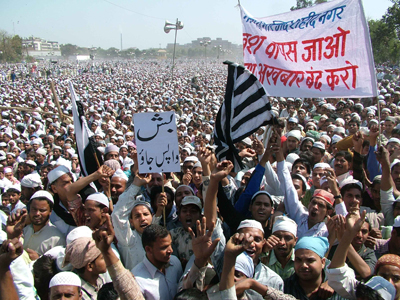Terrorist challenge in South Asia needs an organised network to counter it
The issue of terrorism in South Asia is of course a most involved, complex and delicate matter. It is something on which many observers see fit to proclaim, despite few having any sort of detailed knowledge. It is furthermore an issue in relation to which it is easy to make massive generalisations, but this is without doubt a trap for the unwary analyst.
The miracle is that until 26/11 many Westerners outside of the security sphere were not really aware of the issue of terrorism in India. This may seem amazing, but before 2008, Kashmir was probably the only well-known problem. Prior to that, when attacks occurred in cities, they rarely, if ever, affected Western visitors and so did little to affect the country’s international reputation.
Even now, the Maoist movement is little known and greatly misunderstood by visitors; few people know or care about the issues in the Northeast; and many security experts have missed the activities of some elements of Sikh extremist groups.
This may be a surprise to some readers, who probably consider — with some merit — that Nato could perhaps have learned some lessons from the Indian armed forces when it came to fighting a COIN campaign in the region. Indian colleagues (both police and army) often cite the Punjab as a successful example, and it is certain that this is not well known in the West, despite its clear importance. However, security in the cities remains the key factor, particularly for foreign businesses, increasing numbers of which are choosing to invest in the vibrant and fast-growing Indian economy. The consequence of 26/11 — and accompanying developments in the expertise of terrorists, and their media awareness — has been a point of major concern as it could have a negative impact on the economic growth of India.
Of course, it is only to be expected that the world’s largest nation has a proportional share of problems. Loosely speaking, terrorism in the country could be divided into two types; domestic and international. However, the situation with many of India’s neighbours is such that there is an international influence in more or less all aspects of terrorism in the country. This greatly complicates the matter, as any incipient movement has ready access to all forms of support, be it physical, financial or theoretical.
This reflects how terrorism has perhaps become a strategic weapon of great utility for some countries in South Asia, offering them a reach and impact, they could not otherwise afford. This affects not just India but also the wider region. Some elements in Pakistan certainly seem to countenance the use of terrorist organisations to offset what they regard as threats emanating from India, for example in Afghanistan, where Indian workers and financial donors are having a significant effect on development. In this continuation of the regional ‘great game’ plausibly deniable terrorism is possibly being used to offset political advantage, especially, given a mutually deterrent atomic standoff that precludes any other sort of aggressive action.
Of course, the question remains as to how far this is the ‘official’ policy for Islamabad. Anecdotes indicate that US advisors in Pakistan, a few years ago, would request that the government shut down a particular training camp. There would be a consensus over this, and the camp would duly close, only to reopen again the next day. The advisors would then try again, this time, requesting that the total number of camps be reduced. This would happen, but through the merger of two camps, meaning that there was no real effect on the net outcome. Such tactics reflect Islamabad’s duality; being between a rock and a hard place, trying to keep Washington happy whilst also not losing capability. An alternative but fully plausible explanation is that there are elements that are not fully under control, particularly in ISI, which of course played a substantial role in preparing and equipping many militant organisations for service in Pakistan’s northern neighbour.
Further afield, many also underestimate the role that Iran has to play. Teheran — and particularly the IRGC — is suspected of playing many sides against the middle, in effect, hedging its bets.

Furthermore, the US presence in Iraq and Afghanistan is seen by the Iranians as a major threat, which helps explain why Iranian arms would go to Sunni militants in Afghanistan, even though some end up in the hands of Jundullah — a movement which is fighting and killing Iranians in Sistan-va-Baluchistan. Here, it is worth noting that the main drivers for Iranian nuclear weapons development include not just Israeli capability but also that of Pakistan, which is after all a neighbour with potential stability problems and a deep-rooted religious rivalry with the Shia powers of Teheran.
Some of these complex relationships baffle observers, but they are consistent with the historical pattern of politics in the region. Ironically, this is something that Britain at least once understood well. After all, the fact that the names of tribes causing trouble on the North-West frontier in this day and age are ones that civil servants from two generations ago would have known well. In some respects nothing changes, and the echoes of history ring longest of all in the mountains of Afghanistan.
We now live in a media age, something that Lashkar-e-Taiyyaba and its sponsors knew well when they organised the 26/11 raid, which remains one of the two most organised terrorist operations in history. This offers a new dimension to long-lasting problems and is something that has greatly multiplied the effects of terrorism. The lesson is one that other movements have identified with and we may see this applied more widely.
India’s big test post-26/11 was of course the Commonwealth Games in New Delhi last year. It is certain that it faced a large degree of threat, and for months there were indications that numerous groups were receiving additional support and funding. For example, the Indian Mujaheedin appeared to be resurgent, despite having incredibly limited bomb-making capability, and a series of improvised IEDs in the north-west of the country suggested activity by a Sikh organisation. Even the Maoists were receiving support and were intensifying their activity. The period was thus a nervous one for observers, sponsors, participants and spectators — and quite possibly, for the general population too. And yet, with the exception of one abortive effort, the Games were a huge succes.
This was a significant triumph and yet the convoluted nature of terrorism in the region meant that — as unfortunately proved to be the case — it was not a case of ‘if’ but rather ‘when’ the next incident would occur. The strategic environment has not yet changed, and much hinges on the fate of Afghanistan. The withdrawal of US troops may even increase the rate of attacks on Indian organisations there, whilst changes in the strategic status quo will have yet further implications. Aside from Afghanistan, developments in Pakistan, Iran and to a lesser extent, Central Asia are of critical importance, whilst the stances of Nepal and Bangladesh will also have a clear bearing on India’s security.
As regards the future, the primary foreign concern remains the safety of Indian cities, which is where they have invested in facilities, services or supply chains. For many, even the Naxalites are of secondary importance (except, in the case of infrastructure providers, who may be more active in regions that are affected). This also chimes with the current Western focus on al Qaeda-linked networks, which of course includes LeT. Groups linked to Pakistan — or at least to Pakistani territory — have the most support and capability and are widely believed to be planning more operations, although plausible deniability will continue to be a feature of any possible future attacks. In this respect any operation will aim to stop short at a point where India might escalate the situation, the aim almost certainly being to damage ‘brand India’ rather than precipitate another Kargil-style conflict. The most likely scenario that Western analysts foresee are multiple bombings in a major city, with crowded places as the main targets.
Given undeniable credibility and the consistent intent of the many terrorist organisations capable of operating in India, the risk is simple: threat fatigue. To take just one example, businesses in Mumbai receive a plethora of more or less accurate intelligence and warnings that result in a significant amount of disruption. The eventual output is that they stop paying heed to these; indeed, they cannot afford to do otherwise, else the effects would be too great. In absence of a better and more reliable feed of intelligence, the key is better preparedness for a crisis.
The picture may be a grim one, but it is a reality that terrorism is set to be a constant feature of our existence. It has more effect now than ever, since the essential medium — ready publicity — has never been more readily available. Threats are increasingly networked, organised and well-trained, with best practice and training materials being available on the internet, courtesy al Qaeda. Furthermore, terrorism in South Asia is indubitably tied up with regional conflicts and complex international relations. The challenge is clear and undeniable. To meet it, we must all be better networked amongst ourselves, and be ready to bring a comprehensive and holistic approach to try and solve the many underlying problems that serves as drivers.


 Justin Krump
Justin Krump